Common menu bar links
Breadcrumb Trail
ARCHIVED - Expenditure Review of Federal Public Sector - Volume Two - Compensation Snapshop and Historical Perspective, 1990 to 2003
 This page has been archived.
This page has been archived.
Archived Content
Information identified as archived on the Web is for reference, research or recordkeeping purposes. It has not been altered or updated after the date of archiving. Web pages that are archived on the Web are not subject to the Government of Canada Web Standards. As per the Communications Policy of the Government of Canada, you can request alternate formats on the "Contact Us" page.
2. Total Compensation in the Core Public Service and Separate Employer Domains
This chapter begins by reporting on total compensation—that is, salaries, wages, benefits and other compensation—in the core public service and separate employer domains separately.
Calculating total compensation
Calculation of total compensation requires deciding on a method. This report uses what can be called the "actual employer expenditure" method. That is, we report items like pensions based on the costs incurred by the federal government as a result of employing people during the year. For benefit plans that are externally insured, the expenditure is composed of the government's insurance premiums, while for the plans that are not externally insured the expenditures represent the benefits paid, plus the administration costs.
An alternative approach is to try to estimate the value to employees of various benefits. During the 1980s, for example, the Treasury Board Secretariat invested considerable effort in calculating the value of employment security. For insurance such as disability insurance, one can use actuarial techniques to estimate how much employees would have to pay to get equivalent protection. While the "value to employees" approach is conceptually interesting it is not convincing to most people because it is based on assumptions and calculations that are both debatable and hard to understand. In setting up a more consistent approach for reporting federal compensationin the future, it would be useful to employ more of an accrual approach. For example, retroactive payments should be attributed to the year to which they relate, and, as has been done in the Public Accounts of Canada since 2003, the cost of future benefits such as severance pay and retirement benefits would be attributed to the year when they were earned by active employees.
Total compensation—Core public service domain
Calculating on the basis of estimated actual expenditures, the federal government spent about $12.4 billion on compensation for the employees of the core public service domain in 2002–03, including about $9.0 billion[5] for salaries and wages. Dividing this latter amount by the average number of total employees in the core public service yields an average salary of about $53,300,[6] while total compensation per employee averaged about $73,400. In aggregate, employer‑paid components other than regular salary amount to about 38% of total regular pay.
Figure 2004 illustrates our findings regarding total compensation in 2002–03 for the core public service domain.
Figure 2004
Illustration of main components of total compensation in the core public service domain, 2002–03
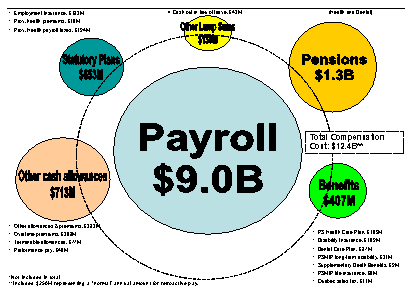
Figure 2005
Actual annual salaries distribution in the core public service domain by $5,000 bands, March 31, 2003*
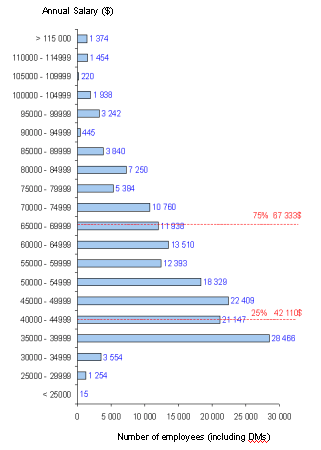
* The salaries are displayed in $5,000 bands, except at the top level where all salaries above $115,000 are combined in one band for simplicity.
As of March 31, 2003, the general distribution of actual annual salary levels in this domain was as illustrated in Figure 2005. Fewer than 5,000 employees (3.0%) earned less than $35,000 per year; conversely, only about the same proportion earned more than $100,000. The lowest three quartiles earned less than $67,333; the lowest quartile earned $42,110 or less per year. The average salary on March 31, 2003 was $54,410, as noted in endnote 2.
Table 2006 lists the average salaries of the ten most populous classification groups in this domain. Together these groups included just over two thirds of the employees; the remaining more than 65 classification groups covered the other third. Among the top ten groups, average salary ranged from $107,000 for the Executive group, to $38,600 for the Clerical group.
|
Table 2006 Employment and salaries—ten most populous classification groups, March 2003 |
|||
|
Group |
% of total |
Average |
% |
|
CR |
19.1 |
$38,600 |
13.6 |
|
AS |
12.0 |
$52,600 |
11.6 |
|
PM |
10.2 |
$54,500 |
10.2 |
|
CS |
6.7 |
$58,600 |
7.2 |
|
EG |
3.9 |
$55,000 |
4.0 |
|
CX |
3.7 |
$46,900 |
3.2 |
|
GL |
3.4 |
$39,200 |
2.5 |
|
ES |
3.3 |
$71,200 |
4.3 |
|
EX |
2.5 |
$107,000 |
4.9 |
|
SI |
2.1 |
$50,835 |
2.0 |
|
Subtotal |
66.9 |
|
63.4 |
|
Total core public service domain |
|
$54,410 |
|
Table 2007 lists the average salaries for the ten largest departments in the core public service domain. As with the largest classification groups, the 10 largest departments comprised two thirds of the population. The average salary among these departments ranged from $60,900 in Environment Canada to $47,600 for the civilian employees of National Defence. In general, the more operationally focused institutions had a lower average salary. Given the differences in salary levels for various occupations, it is evident that the average salary of a particular department will depend on the mix of classification groups making up its workforce.
|
Table 2007 Average salaries for the ten largest departments, March 2003 |
|||
|
Departments |
% of total employees |
Average salary |
% of total salaries |
|
Human Resources Development |
14.2 |
$49,700 |
12.9 |
|
National Defence |
11.8 |
$47,600 |
10.3 |
|
Correctional Service Canada |
8.6 |
$50,600 |
8.0 |
|
Public Works and Government Services |
7.7 |
$56,000 |
7.9 |
|
Fisheries and Oceans |
6.3 |
$52,950 |
6.1 |
|
National Health and Welfare |
5.4 |
$58,150 |
5.7 |
|
Agriculture and Agri‑Food |
3.6 |
$55,500 |
3.7 |
|
Statistics Canada |
3.5 |
$55,800 |
3.6 |
|
Industry |
3.4 |
$59,950 |
3.7 |
|
Environment |
3.4 |
$60,900 |
3.8 |
|
Subtotal |
67.8 |
|
65.8 |
|
Total, core public service |
|
$54,410 |
|
Total compensation—Separate employer domain
The general regime for managing personnel costs among the separate employers[7] provides a kind of delegated autonomy. By policy, such employers must obtain the approval of the Treasury Board (in practice the President on the advice of the Secretariat) for a detailed negotiating mandate. Section 112 of the Public Service Labour Relations Act specifies that in order to enter formally into a collective agreement, a separate employer needs to obtain the approval of the Governor‑in‑Council. This regime aims to ensure that collective agreements are generally consistent across appropriation‑dependent organizations.
The most important point about separate employers as a domain is that each organization is distinct. Each establishes its own policies and practices for people management in areas such as staffing, classification, collective bargaining, and compensation philosophy generally.
Population of separate employers
In 2003 there was one very large separate employer, the Canada Customs and Revenue Agency (CCRA),[8] with over 50,000 employees in March of that year. By itself, CCRA constituted three quarters of the separate employer domain.
There are three other relatively large (over 3,000 employees) separate employer organizations:
- the Canadian Food Inspection Agency (CFIA), with over 5,300 employees;
- the National Research Council (NRC), with about 3,900 workers; and
- the Parks Canada Agency (PCA), with about 3,300.[9]
Most of the remaining separate employers are small, having fewer than 600 employees each.
There are two security‑related organizations among the separate employers: the Canadian Security Intelligence Service (CSIS) and the Communications Security Establishment (CSE). For security reasons, we do not provide details on these entities in this report. There is also an organization known as "Statistical Survey Operations" whose employees are appointed pursuant to the Statistics Act.[10] In March 2003, its staff numbered about 2,300, with an estimated annual salary cost of $30.2 million. We take note of this organization here, but we do not include it further in our analysis.
Figure 2008 illustrates the components of total compensation in the separate employer domain, showing a total compensation cost of about $4.6 billion.
Figure 2008
Total compensation components, separate employer domain, 2002–03[11]
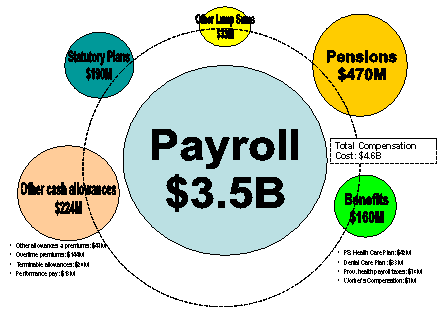
Payroll, population and average salaries
Total regular payroll for the separate employer domain in 2002–03 was about $3.5 billion.[12] Table 2009 summarizes the employee population, salary mass, and average salary in March 2003 for those separate employers with more than 50 workers.[13] From this table it is evident that the variation in average salaries is greater than among the 10 largest departments in the core public service domain.
CCRA had the lowest average salary at $49,100, followed closely by Parks Canada at $49,550. At the high end we find specialized regulatory agencies such as the Office of the Superintendent of Financial Institutions (OSFI), with an average salary of about $81,600, the Public Service Staff Relations Board (PSSRB) at $74,900, and the Financial Transactions and Reports Analysis Centre of Canada (FINTRAC) at $72,150.
In the rest of this section, to avoid excessive detail, we will focus only on the four largest separate employers; together they employ over 90% of those working in this domain. As Table 2010 illustrates, the distribution of occupational groups in the main separate employer populations reinforces their distinctiveness. In a number of cases, the classification groups differ from those in the core public service domain. For example, CCRA set up a Management (MG) group to put together those with significant people management responsibilities from all the various groups inherited when CCRA was established in 1999. In another such case, the NRC has a Research Officer (RO) group, reflecting its main business activity.
The main job categories differ considerably. On the one hand Program Administration (PM) and Clerical and Regulatory (CR) employees dominate CCRA numerically, with about 60% of the staff. At CFIA, the major job areas are the Engineering and Scientific Support (EG), Clerical and Regulatory (CR), Biologist (BI), and Veterinary Medicine (VM) groups, comprising together about 78%. At Parks Canada, the top four groups constitute about 60% of employees. For the NRC, the two largest groups, the Research Officers and the Technicians, by themselves, are 60% of the organization.
Because CCRA by itself is a very large employer (75% of the separate employer domain, and equivalent to about 30% of the core public service domain) we have included an overview of the distribution of CCRA employees by $5,000 income bands (Figure 2011). In general, this agency's salary structure reflects a greater proportion of lower‑ and middle‑income earners than the core public service. About 16% (versus 3% in the core public service) earned below $35,000, whereas only about 0.4% earned more than $100,000 (versus 3%). The first quartile income maximum is only just over $2,000 lower, but the third quartile income maximum is over $12,000 less, reflecting a considerable concentration in the middle‑income range.
|
Table 2009 Employee population and salary for separate employers with more than 50 employees, March 2003 |
|||||
| Separate employers | Employees | Payroll | Average salary | ||
| Total number | % of total domain | ($M) | % of separate employer domain | ||
|
Canada Customs and Revenue Agency |
51,128 |
75.0% |
2,510.6 |
71.9 |
$49,100 |
|
Canadian Food Inspection Agency |
5,349 |
7.8% |
290.0 |
8.3 |
$54,200 |
|
National Research Council |
3,910 |
5.7% |
233.6 |
6.7 |
$59,750 |
|
Parks Canada Agency |
3,293 |
4.8% |
163.2 |
4.7 |
$49,550 |
|
Office of the Auditor General |
599 |
0.9% |
41.1 |
1.2 |
$68,600 |
|
Canadian Nuclear Safety Commission |
482 |
0.7% |
33.0 |
0.9 |
$68,400 |
|
Office of the Superintendent of Financial Institutions |
451 |
0.7% |
36.8 |
1.1 |
$81,600 |
|
National Film Board |
439 |
0.6% |
24.7 |
0.7 |
$56,400 |
|
Natural Sciences and |
296 |
0.4% |
16.5 |
0.5 |
$55,900 |
|
National Energy Board |
295 |
0.4% |
20.1 |
0.6 |
$68,200 |
|
Canadian Institutes of Health Research |
246 |
0.4% |
14.6 |
0.4 |
$59,200 |
|
Social Sciences and |
162 |
0.2% |
9.3 |
0.3 |
$57,400 |
|
Fin. Transactions and |
160 |
0.2% |
11.5 |
0.3 |
$72,150 |
|
Indian Oil and Gas |
72 |
0.1% |
4.6 |
0.1 |
$63,900 |
|
Public Service Staff Relations Board |
65 |
0.1% |
4.9 |
0.1 |
$74,000 |
|
Other Separate Employers |
1,209 |
1.8% |
74.8 |
2.1 |
$61,869 |
|
Total |
68,156 |
100% |
3,489.4 |
100.0 |
|
|
Table 2010 Major occupational groups in the largest separate employers, March 2003 |
|||||||
|
|
CCRA |
CFIA |
PARKS |
NRC |
Other |
Total |
% |
|
Program Manager (PM) |
20,437 |
200 |
269 |
|
142 |
21,048 |
30.9 |
|
Clerical and Regulatory (CR) |
9,964 |
655 |
343 |
|
56 |
11,018 |
16.2 |
|
Auditors (AU) |
4,970 |
|
|
|
0 |
4,970 |
7.3 |
|
Management (MG) |
4,231 |
|
|
118 |
0 |
4,349 |
6.4 |
|
Computer Systems (CS) |
3,263 |
121 |
77 |
272 |
82 |
3,815 |
5.6 |
|
Administrative Services (AS) |
2,357 |
295 |
332 |
185 |
259 |
3,428 |
5.0 |
|
Engineering Support (EG) |
11 |
2,511 |
60 |
|
0 |
2,582 |
3.8 |
|
Data Processing (DACON) |
1,922 |
|
|
|
5 |
1,927 |
2.8 |
|
General Labour (GL) |
41 |
|
649 |
|
66 |
756 |
1.1 |
|
General Technical (GT) |
47 |
|
693 |
|
0 |
740 |
1.1 |
|
General Services (GS) |
376 |
12 |
182 |
|
1 |
571 |
0.8 |
|
Biologists (BI) |
|
453 |
12 |
|
40 |
505 |
0.7 |
|
Veterinarian Medecine (VM) |
|
577 |
|
|
0 |
577 |
0.8 |
|
Research Officer (RO) |
|
|
|
1,250 |
0 |
1,250 |
1.8 |
|
Technicians (TC) |
|
|
|
1,084 |
234 |
1,318 |
1.9 |
|
Administrative Support (AD) |
|
|
|
510 |
204 |
714 |
1.0 |
|
Subtotal |
47,619 |
4,824 |
2,657 |
3,419 |
1,089 |
59,568 |
87.4 |
|
Total Separate employers |
51,128 |
5,349 |
3,293 |
3,910 |
4,476 |
68,156 |
100.0 |
|
% |
93 |
90 |
81 |
87 |
24 |
87.4 |
|
Figure 2011
Distribution of actual annual salaries by $5,000 bands in the Canada Customs and Revenue Agency, March 2003
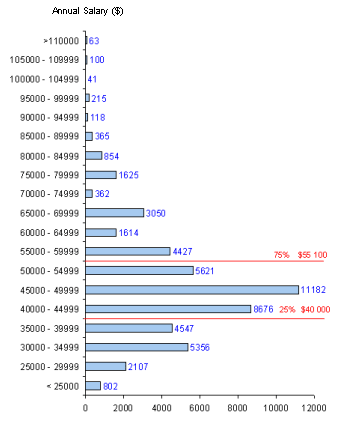
Retrospective — Employment and salary changes, 1990 to 2003
Our historical analysis combines the core public service and the separate employer domains because, until the late 1990s, the core public service included what now constitutes the bulk of the separate employer domain. As late as 1997, the separate employer domain was small, employing fewer than 9,000 people in total. In 1997, the Canadian Food Inspection Agency was created as a separate employer, followed by Parks Canada and the Canada Customs and Revenue Agency in 1999. These three agencies accounted for about 88% of employment in the separate employer domain, and their employees numbered nearly 60,000 in March 2003. This is equivalent to over one third of the core public service domain. It is therefore imperative to deal with the two domains together if we are to make meaningful comparisons over the period from 1990 to 2003.
Employment change
Through the early 1990s, the general pattern of total employment in these two domains combined was stability. The domains employed close to 245,000 workers in that period. Starting in earnest in 1994–95, there was a decline to just under 200,000 bythe two years 1997–98 and 1998–99. By 2002–03 total population had increased back to nearly 235,000. Figure 2012 below portrays the evolution of employment in the two domains, both independently and combined. The increase in employment after the mid to late 1990s approached but did not attain the 1990–91 levels, even as late as 2002–03.
The statistical low point for employment in our period of analysis was 1998–99. Between then and 2002–03, we see employment growth of over 20%. While total employment in the core public service and separate employer domains fell by about 50,000 net over six or seven years, and then rose by about 40,000 over the last four or five years up to 2002–03, our main interest is in the growth period that started in 1999–2000.
Figure 2012
Employment in the core public service and the separate employer domains, 1990–91 to 2002–03
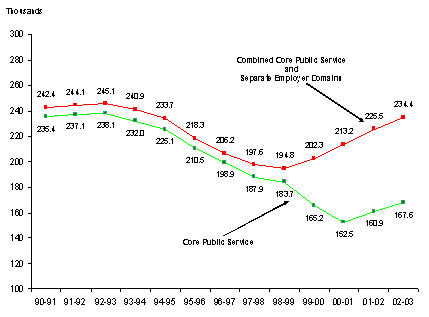
Salary levels
The complementary picture for salaries and wages (regular payroll) is set out in Figure 2013. It shows a modest increase over the early 1990s, followed by a distinct decline in the second half of the 1990s, with a strong growth through the period 1997–98 to 2002–03.
Figure 2013
Salaries and wages (regular payroll) in the core public service and separate employer domains, 1990–2003
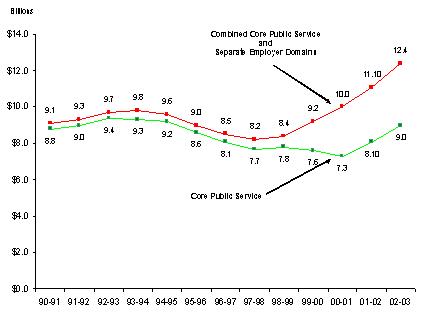
Figure 2014 shows the evolution of total employment and total salaries for the two domains combined on an index basis (1990–91=100). The salary figures are presented in constant dollars, thus removing the effect of inflation. Comparing total salaries between 1990–91 and 2002–03 in constant 2002–03 dollars shows a growth of about 7%.
Figure 2014
The evolution of total employment and total salaries for the combined core public service and separate employers domain, 1990–91 to 2002–03
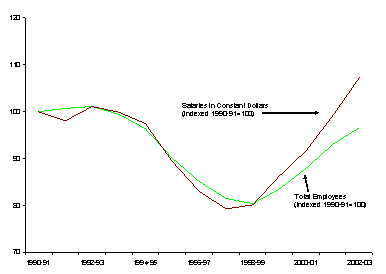
For the salary mass, the low point was reached in 1997–1998. Between that year and 2002–03, we see a 51% current dollar increase in the total salary mass, which is equivalent to about a 35% increase in constant 2002–03 dollars. This rate of growth in the salary mass raises the question of what drove the change. The next chapter answers that question.
For the salary mass, the low point was reached in 1997–1998. Between that year and 2002–03, we see a 51% current dollar increase in the total salary mass, which is equivalent to about a 35% increase in constant 2002–03 dollars. This rate of growth in the salary mass raises the question of what drove the change. The next chapter answers that question.
